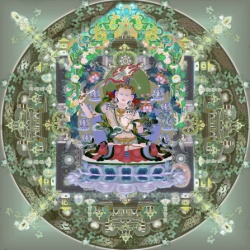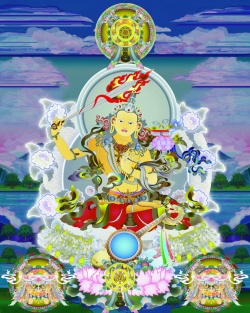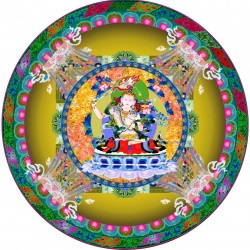The Method for Using MO Divination Manual
Before making a divination, it is recommended that you perform a few preliminary meditations. First of all, imagine that the great Bodhisattva of Wisdom, Manjushri, is in the sky in front of you. His body is yellow, with one face and two hands. His right hand holds aloft the flaming sword of wisdom, while his left hand holds at his heart the stem of a blue lotus flower. The flower blossoms beside his left ear, and upon it rests a copy of The Book of the Perfection of Wisdom (Prajnaparamita). His two feet are crossed in the vajra posture and he appears in the form of a sixteen-year-old boy. Thinking that he is blessing the dice with which you are going to make the prediction, recite the following verse:
- Om, the magnificent Manjushri who possesses the eye of transcendental wisdom which unobstructedly sees all three times, please take heed of me. Through the power of the truth of the non-deceiving interde- pendently arising Three Jewels and Three Roots please make clear what should be accepted and what discarded.
Next, you should recite the mantra of Manjushri:
- OM AH RA PA TSA NA DHI
This mantra, which is pronounced OM AH RA PA CHA NA DEE, is one of the principal mantras of Manjushri. Though having no specific translation, the five middle syllables -AH RA PA TSA NA-are said to represent the five families of the Buddhas, while the final syllable, DHI, represents the wisdom of all the Buddhas.
You should also recite the Mantra of Interdependent Origination:
- OM YEDHARMA HETU PRA-BHAWA HETUNTE KHEN TA THAGATO HAYA WATET TE KHEN TSAYO NIRODHA EWAM WADI MAHA SHRAMANA SOHA
This mantra, which is pronounced OM/YEA DAR MA/HEH TOO/PRA BAH WAH/HEH TUN TAY/ KEN/TA T'A GA TOE/HA YA/WA TET/TAY/KEN/ CHA YO/NEE RO DA/ EHVAM/WADEE/MA HA/ SHRA MA NA/SO HA, may be roughly translated as:
- The Tathagata (Buddha) has explained the origin of those things which arise from a cause; their cessation too he has explained; this is the doctrine of the great sage.
This mantra is actually a pith instruction of the Buddha's profound insight into interdependent origination.
The first mantra should be recited three or seven times (or more, if you wish), and the second mantra should be recited one, three or seven times. In conclusion, blow upon the dice to endow it with the power of the mantras. Then, keeping in mind your question and also the name of the person for whom you are casting the prediction (if it is not being thrown on your own behalf), cast the dice two times and. then examine the answer. For example, if at the first throw of the dice the letter RA appears, and at the second the letter DHI appears, then you should search for the answer RA DHI, which is number 12.
The Answers
Each answer of this prediction system is divided into several parts. First, the name of the answer is given; the lead paragraph explains the name using metaphors and symbols, while the next paragraph characterizes the answer, often by quoting some source in order to show the general trend of the answer. Following this, eleven categories are listed with specific predictions for each, and finally a supplementary name is given.
The eleven main categories cover all the possible questions that you put forth to the book. They are listed below, with a brief description of the realm of experience that each covers.
- Family, property and life: foundations of your life, including anything dealing with your physical life or vitality, your family and property.
- Intentions and aims: the goals and aims you may seek within your business, as well as other aspects of your life.
- Friends and wealth: the people you associate with as well as your financial affairs and business affairs.
- Enemies: description of any enemies you may have.
- Guests: this category was necessary in Tibet where it might take a guest several months to arrive, so there was always a concern for visitors en route.
- Illness: the state of your health.
- Evil spirits: possibility of your troubles arising from some negative forces, such as spirits or unwholesome environmental conditions.
- Spiritual practice: obstacles and outlook for spiritual practices.
- Lost article: whether a lost article can be found and where.
- Will they come, and will the task be accomplished: the meeting with another and the possibility of accomplishing some work.
- All remaining matters: covers any other question which may not fall under any of the above categories.
Not only are answers given, but also advice is proffered regarding how to overcome particular problems. Generally, a specific spiritual practice, a ritual or the reliance upon a certain deity is proposed. The common Tibetan did not have the ability to perform these rituals or meditations, so it was (and continues to be) the practice for the inquirer to approach the local monastery or those who were learned in the performance of rituals to do whatever was needed on his or her behalf. Therefore, although you may be unfamiliar with some of the names of deities, rituals and texts, the authors left them in the translation with the thought that you may have the opportunity to approach someone with that knowledge. Once these remedies are understood they can be used by the inquirer to help overcome the problem or to accomplish one's aims and wishes.
To ascertain whether an answer is very firm or weak, it is advisable to throw the dice two more times. If the same two syllables are repeated, then this means that your ansWer is very firm. If the two syllables reverse themselves, then the answer is a weak one. If the two syllables of the subsequent toss are different, then your answer is good as it stands.
You can also look into the answer from other perspectives. For example, whether the prediction is favorable or unfavorable for the present time, it is good to perform another throw of the dice in regards to the future. In this way you can make predictions for different times. If the question you ask is a very serious one, such as one concerning a major illness, then it is good to make several predictions about it. If it is only a small matter, then one prediction is enough.
Supplementary Interpretive Material
The six syllables of the dice allow for a range of interpretation. Several levels of meaning are listed below.
In a sense, there is an outer and inner meaning to the syllables and their relationship to each other. It is said that if the two syllables appear the same, such as DHI DHI, PAPA, etc., then the outer and inner meanings are the same.
In regards to your relations with others, you can throw two predictions. The first concerns yourself, while the second concerns the other person. Otherwise, even within one prediction you can regard the first syllable to represent yourself while the second syllable represents the other person. Then examine the relationship between the two syllables.
When the syllable DHI appears first, we can see the following meanings:
- if DHI DHI appears, this indicates increasing;
- if DHI AH appears, this indicates equanimity;
- if DHI RA appears, this indicates unimpeded continuity;
- if DHI TSA appears, this indicates favorableness and the likelihood of the quick accomplishment of the question;
- li DHI PA appears this indicates that activities such as marriage, engagements, and the like will be good.
If the syllable DHI appears as the second part of the answer, then this is not bad aid the propitiation of deities will find success. The appearance of the syllable DHI portents increasing for those who had nothing previously.
If the syllable AH appears first in the combination, then the answer is only mediocre. If it appears as the second part of the answer, then you will have no obstacles in regards to your inquiry. In regards to curing a disease, the appearance of the syllable AH is good The syllable RA is concerned with the desires of your mind; the syllable TSA is concerned with messages ; PA with the joy of your property; while NA is connected with your area or country.
The syllables AH, DHI ,RA and TSA have insight wisdom, violence and the waning moon in common, while NA and PA have concentration, gentleness and the waxing moon in common .Furthermore, RA represents the voice and speech, TSA the airs of the body (this also includes the breath and so is in relation to air diseases), while NA represents the body and PA the veins of the body.
In regards to various types of activities:
- PA is for activities of peace or purification;
- RA is for activities of power or subduing;
- NA is for activities of increasing or prosperity;
- TSA is for activities of violence or destruction;
- DHI is for activities of excellence;
- AH pervades all activities.
In regards to the elements:
- AH represents empty space;
- RA represents fire;
- PA represents water;
- TSA represents air;
- NA represents earth;
- DHI represents transcendental wisdom.
In regards to the parts of the body:
- RA represents the eye;
- AH represents the ear;
- NA represents the nose;
- PA represents the tongue;
- TSA represents the body;
- DHI represents the mind.
In regards to the objects of the senses: RA represents forms;
- AH represents sounds;
- NA represents odors;
- PA represents tastes;
- TSA represents tactile objects;
- DHI represents thoughts.
In regards to the inner parts of the body:
- RA represents the heart and small intestines;
- AH represents the lungs and large intestines;
- NA represents the gall bladder and stomach;
- PA represents the kidneys ,the organ which holds urine, and the reproductive organs;
- TSA represents the liver;
- DHI represents the semen.
In regards to the spheres of the world:
- AH and DHI represents the tky;
- NA and PA represent the earth;
- RA and BA represents the area between the earth and sky.
In regards to gender:
- NA and PA are female;
- DA and TSA are male;
- AH and DHI are neuter or hermaphrodite.
In regards to directions which will indicate the direction a thief or someone else has gone, where a lost article may befound, the direction in which one should move, and the like:
- AH and DHI are central;
- PA is south;
- RA is west;
- TSA is north;
- NA is east;
- AH may also be said to pervade all the directions so it indicates no specific direction of its own.
In regards to color:
- RA is red,
- PA is white;
- TSA is green;
- NA is yellow;
- DHI is multicolored;
- AH is neutral with no specific color of its own.
In regards to shapes:
- RA is a triangle;
- PA is a circle;
- TSA is a semi-circle;
- NA is a square;
- DHI is various shapes;
- AH has no specific shape of its own.
In regards to the Buddha families:
- AH is the Tathagata-family of Vairochana;
- RA is the Lotus-family of Amitabha;
- PA is the Jewel-family of Ratnasambhava;
- TSA is the Karma-family of Amoghasiddhi;
- NA is the Vajra-family of Akshobhya;
- DHI lis the Heruka-family of Vajradhara.


